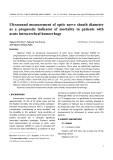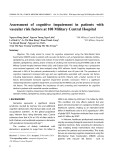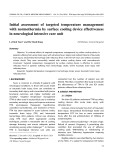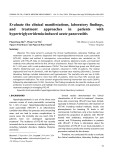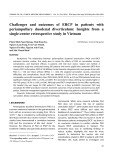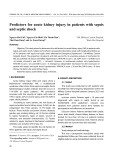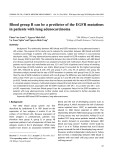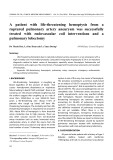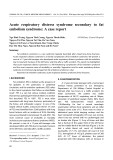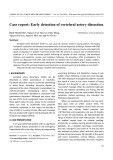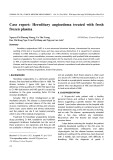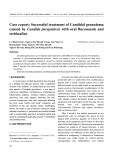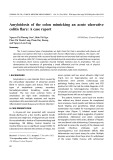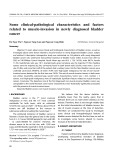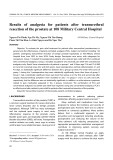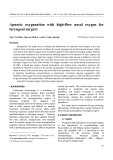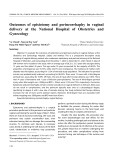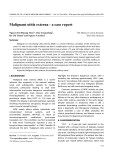
HUE JOURNAL OF MEDICINE AND PHARMACY ISSN 3030-4318; eISSN: 3030-4326HUE JOURNAL OF MEDICINE AND PHARMACY ISSN 3030-4318; eISSN: 3030-4326
202 203
Hue Journal of Medicine and Pharmacy, Volume 15, No.2/2025 Hue Journal of Medicine and Pharmacy, Volume 15, No.2/2025
Study on internet addition status of students and its related factors at
a medical college in Central Vietnam
Pham Thi Thien Thanh1 , Dang Thi Anh Thu2*
(1) Dang Thuy Tram Medical College
(2) University of Medicine and Pharmacy, Hue University
Abstract
Background: The internet has become an indispensable part of daily life. However, excessive use of the
internet can lead to internet addiction, a recognized mental health condition included in the International
Classification of Diseases-11 Revision (ICD-11). During the COVID-19 pandemic, this issue appears to have
worsened due to increased internet use. This study aimed to determine the prevalence of internet addiction
among students at Dang Thuy Tram Medical College in Quang Ngai Province in 2020 and to explore the
associated factors. Materials and methods: A cross-sectional study was conducted among 425 full-time
students at Dang Thuy Tram Medical College in Quang Ngai Province, Vietnam, in 2020, using a self-
administrative questionnaire. Data were collected on demographic characteristics, mental health status and
internet use behaviors. The 20-item Internet Addiction Test (IAT-20) was used to assess internet addiction.
Statistic analyses including Chi-square tests and multivariate logistic regression to explore factors related
to students’ internet addition. Results: The prevalence of medical college students showing mild internet
addiction or more severe conditions was 348 among them, 79.9% had mild internet addiction, 19.8% showed
internet addiction and 0.3% had a severe condition. Regression analysis indicated that internet addiction
was significantly associated with school year (aOR = 2.39, 95%CI:1.08 - 5.29, 2nd year vs 1st year), living
arrangement (aOR = 4.15, 95%CI:1.59 - 10.79, living with friends vs living with family), warnings from academic
advisors about internet use (aOR = 1.7, 95%CI:1.5 - 6.9), and the time spent for the main purpose of internet
use. Conclusion: Internet addiction is highly prevalent among medical college students, especially during
the pandemic period. Efforts should be made to raise awareness among student, families, and academic
institutions about the risks of internet addiction and promote healthier internet use behaviors.
Keywords: COVID-19 pandemic, internet addiction, students, medical college, central Vietnam.
*Corresponding author: Dang Thi Anh Thu. Email: dtathu@huemed-univ.edu.vn
Received: 11/12/2024; Accepted: 15/4/2025; Published: 28/4/2025
DOI: 10.34071/jmp.2025.2.28
1. INTRODUCTION
The internet has become an indispensable part
of our daily lives, offering numerous benefits such
as access to online information, entertainment, and
social interaction. It has a particularly significant
impact on education and training [1, 2, 3]. However,
excessive use can lead to internet addiction, a mental
health condition recognized by the World Health
Organization. Gaming disorder is now included
in the addictive behavior disorders of the ICD-11
classification [4].
Internet addiction has both immediate and
long-term consequences for individuals and society.
Changes in brain structure and neurochemical
activities caused by excessive internet use are a
growing concern among researchers and educators,
particularly regarding the development of young
people [5, 6]. Several studies have identified adverse
functional and psychosocial outcomes associated
with problematic internet use. Unsurprisingly, these
studies also report evidence of declines in both
official academic performance and self-reported
scores among children and adolescents [7]. Regarding
physical health, Nguyen Minh Tam et al (2017)
found that 57.3% of school students experienced
poor sleep quality due to excessive internet use,
while the rate of colleges/universities was 51.6%. In
Vietnam, the internet is considered a highly popular
communication tool among young people, including
schoolchildren and college/university students [8].
The Internet has become a widely used and
essential tool for supporting student’s learning,
especially those in the health sector - an important
workforce for public health care [9]. Currently, no
studies have investigated internet addiction among
students at the medical and pharmacy college in Quang
Ngai Province. To address this gap in knowledge, we
conducted a study titled “Internet Addiction Status
and Related Factors of Students and its related factors
at Dang Thuy Tram Medical College, Quang Ngai
Province.” The aim of this study is to identify students
who show early signs of internet addiction, enabling





